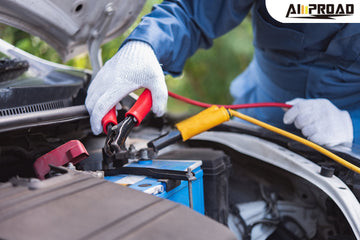
The idea of keeping a portable car jump starter in your vehicle for emergencies is practical, especially considering the unpredictability of car battery failures. However, the safety and longevity of these devices can be influenced by how and where they are stored. One major concern is the interior temperature of a car, which can soar to 70-80°C (158-176°F) on a hot sunny day. This extreme heat can be detrimental to the lithium-ion cells commonly found in modern jump starters. For the good quality jumper starter like AMPROAD iRock40, it's generally safe to keep a portable car jump starter in your vehicle.
The Impact of Temperature on Lithium-Ion Batteries
Lithium-ion batteries are widely used in portable jump starters due to their high energy density and compact size. However, they are sensitive to temperature extremes. When stored in high temperatures, these batteries can experience accelerated degradation. Here’s why:
-
Heat Degradation: Prolonged exposure to temperatures above 50-60°C (122-140°F) can cause lithium-ion cells to deteriorate. The heat can break down the electrolyte, leading to decreased battery capacity and potentially causing the battery to swell, leak, or, in extreme cases, catch fire.
-
Thermal Runaway: At excessively high temperatures, lithium-ion batteries can enter a state known as thermal runaway. This condition leads to a rapid increase in temperature and pressure inside the battery, potentially resulting in a fire or explosion.
Given these risks, it's essential to consider the temperature conditions in which you store your portable battery booster. While modern vehicles are equipped with insulation and air conditioning, parked cars can still become heat traps, especially in summer.
The Role of Direct Sunlight
Direct sunlight can significantly elevate the interior temperature of a car. Parking your vehicle in the sun can quickly turn it into an oven, exacerbating the issues related to heat degradation of lithium-ion batteries. Therefore, it is advisable to avoid leaving any electronic devices, including portable jump starters, in direct sunlight. If possible, park in shaded areas or use sunshades to mitigate the heat buildup inside your car.
Cold Temperatures and Battery Performance

While high temperatures pose a significant risk, extremely cold temperatures can also affect the performance of lithium-ion batteries. Cold weather can reduce the efficiency of the battery, making it less capable of delivering the necessary power to start your car. Here’s what you need to know:
-
Reduced Capacity: In cold temperatures, the chemical reactions within a lithium-ion battery slow down, leading to a temporary reduction in capacity. This means the jump starter might not perform as expected when you need it most.
-
Regular Checks: If you live in an area with harsh winters, regularly check your portable jump starter to ensure it maintains its charge. Some models may come with a built-in temperature sensor to prevent operation in unsafe conditions.
Safety Precautions for Storing Portable Jump Starters
To ensure the safety and longevity of your portable jump starter, follow these storage tips:
-
Avoid Extreme Temperatures: As discussed, avoid leaving your jump starter in conditions where it will be exposed to extreme heat or cold. Store it in a temperature-controlled environment when not in use.
-
Proper Placement: Store the booster batterie in a secure location within your car, such as a glove compartment or under a seat, where it won’t be subject to direct sunlight or physical damage. Avoid placing it in the trunk if the trunk tends to get excessively hot.
-
Physical Protection: Ensure the jump starter is not loose in the car. Secure it in a padded case or compartment to prevent it from moving around and sustaining physical damage, which could lead to short circuits or other malfunctions.
-
Regular Maintenance: Check the battery status regularly. Most portable jump starters come with indicators to show the charge level. Keeping the device charged and ready for use is crucial for its effectiveness during emergencies.
When Keeping a Jump Starter in the Car is Justified
There are situations where keeping a portable jump starter such as AMPROAD iRock40 jump starter in the car makes sense:
-
Frequent Long Drives: If you often travel long distances, especially through remote areas, having a jump starter in the car can be a lifesaver in case of battery failure.
-
Older Vehicles: Older vehicles are more prone to battery issues. Keeping a jump starter in such cars can help you avoid being stranded.
-
Infrequent Use: If you don’t drive your car regularly, the battery may lose charge over time. A portable jump starter can help you get back on the road without needing assistance.
While it is generally safe to keep a portable car jump starter in your vehicle, it is important to consider the storage conditions. High temperatures can significantly degrade the performance and safety of lithium-ion batteries, so avoid exposing your jump starter to extreme heat or direct sunlight. Cold temperatures can also affect battery performance, so regular checks are necessary in colder climates.
By following proper storage practices and regularly maintaining your jump starter, you can ensure it remains a reliable tool in case of emergencies. Understanding these nuances helps in making an informed decision about whether to keep a portable jump starter in your car, thereby enhancing both safety and convenience.
Related article:
How to clean car battery corrosion?



